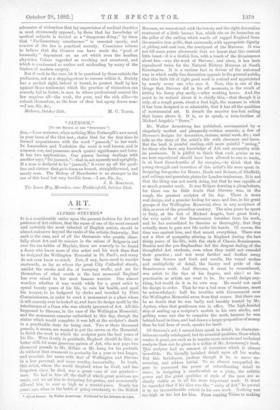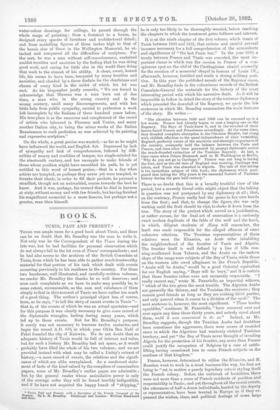ART.
ALFRED STEVENS.*
IT is a considerable satire upOn the present fashion for Art and pretence of Art culture, that the name of one of the most earnest and certainly the most talented of English artists, should be :almost unknown beyond the ranks of the artistic fraternity. But such is the case, and of all the thousands who prattle cheer- fully about Art and its mission in the salons of Belgravia and over the tea-tables of Mayfair, there are scarcely to be found a dozen who know more of this artist and his work than that lie designed the Wellington Memorial in St. Paul's, and many do not even know so much. Few, if any, have cared to wander -eastwards, as far as where the great City Cathedral stands, amidst the smoke and din of hurrying traffic, and see for themselves of what worth is the best memorial England has ever raised to her most famous warrior. One almost wonders whether it was worth while for a great artist to Spend twenty years of his life, to ruin his health, and spoil his temper, to be badgered by clerks and insulted by First 'Commissioners, in order to erect a monument in a place where it will scarcely ever be looked at, and have its design spoilt by the interference of a Dean who was utterly ignorant of Art. All this happened to Stevens,in the case of the Wellington Memorial; -and the monument remains unfinished to this day, though the -statue which would complete it was left at the sculptor's death in a practicable state for being cast.' Two or three thousand pounds, it seems, are wanted to put the crown on the Memorial, to finish the work to which the sculptor gave the best years of his life.Were it only in gratitude, England should do this ; or better still, let some generous patron of Art, who now pays two -thousand pounds to Mr. Millais or Mr. Long for his portrait, .do without that ornament to posterity for a year or two longer, and associate his name with that of Wellington and Stevens in a less personal, and more worthy, immortality. In truth, this artist, whom the world. despised when he lived, and has forgotten since. he died, was a great—one of our greatest— men. He had in him all the stuff of which great geniuses are made, and we set him to designing fire-grates, and occasionally alfowed him to soar as high as a mantel-piece. Nearly ten
going constantly to the British years ago, when in the habit of
* Alfred Stevens. By Walter Armetrong. Publiebod by Le. Librario iel'Art,
Museum, we were struck with the beauty and the right decorative treatment of a little bronze lion, which sits on its haunches on the pillar of the railing which wards off ragged England. from the massive iron grille, that surrounds, with appropriate dignity of gilding and cast iron, the courtyard of the Museum. It was not till some years afterwards that we learnt that this comical little beast—it is a Gothic lion, with a touch of the Renaissance about him—was the work of Stevens ; and since, it has been reproduced twice for the Natural History Museum at South Kensington. It is a curious fact in favour of the universal way in which really fine decoration appeals to the general public, that this little bit of right good work is noticed and appreciated. by nearly every one who sees it. Now, this is one of the things that Stevens did in his off moments, is the result of letting his fancy play easily,—after working hours. And the point to be noticed about it is chiefly this,—that though it is only, at a rough guess, about a foot high, the manner in which it has been designed is so admirable, that it has all the qualities of monumental art. It dwarfs the massive ten-feet railing that looms above it. It is, so to speak, a twin-brother of Michael Angelo's "Dawn."
Mr. Walter Armstrong has published, accompanied by a singularly modest and pleasantly-written memoir, a few of Stevens's designs for decoration, statues, metal work, &c. ; and tells us the story of the artist's life with clearness and force. But the book is painful reading, still more painful "seeing," for those who have any knowledge of Art, and. sympathy with its producers. It is pitiful to think that such genius as we see here reproduced should have been allowed. to run to waste, in at least three-fourths of its energies,—to think that the young strength and invention of this artist's life were spent in designing fire-grates for Messrs. Horde and Robson, of Sheffield, and. ceilings and porcelain plates for London tradesmen. It is not that the thing was not worth doing, but that he was capable of so much grander work. It was Eclipse drawing a ploughshare, for there eau be little doubt that Stevens was, in the rough, the greatest sculptor of his day. There is more real design, and a grander feeling for mass and line, in his great groups of the Wellington Memorial, than in any sculpture of this, or even of the preceding century. The nitie years he spent in Italy, at the foot of Michael Angelo, bore great fruit; the very spirit of the Renaissance breathes from his work, and he has assimilated its theories so thoroughly, that they actually seem to gain new life under his hands. Of course, the time was against him, and that meant everything. There was not a fibre of sympathy stirring in England during the last thirty years of his life, with the style of Classic Renaissance. Ruskin and the pre-Raphaelites led the deepest feeling of the thoughtful Art students, even when they could not remodel their practice ; and Art went farther and farther away from the flowers and fruit and scrolls, the round arches and multiplicity of detail, the luxury and pride of the Renaissance work. And Stevens, it must be remembered, was artist to the tips of his fingers, and alas ! as im- practicable as artists are wont to be. He would design any- thing, but would do it in its own way. He would not spoil his design to eider. That he was a bad man of business, must be acknowledged ; half his troubles with Government over the Wellington Memorial arose from that source. But there can be no doubt that he was badly and harshly treated by Mr. A.yrton, when that gentleman was in office. The high-handed. step of sealing up a sculptor's models in his own studio, and getting some one else to complete the work, because he was behind-hand in time, and had drawn a larger proportion of money than he had done of work, speaks for itself. • Of Stevens's art; I cannot here speak in detail ; its character- istics are easily catalogued, but its essential qualities, those which render it great, are such as to require more minute and technical analysis thau can he given in a notice of Mr. Armstrong's book. This sOulptor had an amount of invention which is almost incredible. He literally lavished detail upon all his works. But this lavishness, profuse though it be, is never un- meaning, and seldom trivial. To an almost unequalled de- gree he possessed the power of subordinating detail to h candle-stick or a plate, the artistic
mass ; in designing
power and the great qualities of style of the man are as clearly visible as in all his more important work. It must be conceded that if his idea was the " unity of Art," he proved it to no inconsiderable extent in his own work. Nothing was too high or too low for him. From copying Titian to making water-colour drawings for ceilings, he passed through the whole. range of painting ; from a footstool to a house, he designed every species of furniture and architectural detail ; and from. modelling figures of three inches high to that of the heroic size of those in the Wellington Memorial, he at- tacked and conquered all the difficulties of sculpture. For the rest, he was a man without self-consciousness, sustained amidst troubles and anxieties by the feeling that he was doing good work, and caring for little else in the world than doing that work to the utmost of his ability. A clean, sweet, honest life, his seems to have been, tempered by many troubles and anxieties, and clouded by a fierce disdain for the charlatans and shams of every kind in the midst of which his lot was cast:' As his biographer justly remarks, "We are forced to acknowledge that Stevens was a man born out of due time, a man who, in the wrong country and in the wrong century, amid many discouragements, and with but little help from public sympathy, carried to perfection a work left incomplete by the Italians of throe hundred years before. His true place is as the successor and complement of the crowd of artists who laboured in Florence and Venice, and many another Italian city, to bring the minor works of the Italian Renaissance to such perfection as was achieved by its painting and expressive sculpture."
On the whole, a great genius was wasted,—as far as he might have influenced the world, and English Art. Depressed by lack of sympathy and lack of comprehension, fettered by diffi- culties of money and crudities of temper, too single-minded for the nineteenth century, and too unsupple to make friends of those whose position might have smoothed his path, he is yet entitled to this word of honest praise,—that in a day when artists are tempted, as perhaps they never yet were tempted, to forsake their ideals, in order to fill their pockets, he pursued a steadfast, though not an untroubled, course towards the best he knew. And it was, perhaps, his reward that he died in harness at sixty, without money and with few friends, but having finished his magnificent memorial to a more famous, but perhaps not a greater, man than himself.



































 Previous page
Previous page